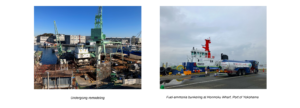In cooperation with Nippon Kaiji Kyokai (ClassNK), NYK and IHI Power Systems have completed the ammonia-fueled tugboat Sakigake. According to the NYK’s research, this is the world’s first ammonia-fueled vessel for commercial use.
Commercial-use ammonia-fueled vessel
Sakigake is 37.20m long, 10.20m wide and has a depth of 4.40m. It has a gross tonnage of 278 tons. The NYK Group company Shin-Nippon Kaiyosha will employ the vessel in tugboat operations in Tokyo Bay over a three-month demonstration period.
 This vessel was a Green Innovation Fund Project initiated in October 2021 under Japan’s New Energy and Industrial Technology Development Organization (NEDO) to develop vessels equipped with domestically produced ammonia-fueled engines.
This vessel was a Green Innovation Fund Project initiated in October 2021 under Japan’s New Energy and Industrial Technology Development Organization (NEDO) to develop vessels equipped with domestically produced ammonia-fueled engines.
Its predecessor, the LNG-fueled tugboat of the same name, was completed in August 2015 as the first LNG-fueled vessel in Japan. After eight years of tug service in Tokyo Bay, the vessel was docked at NYK Group’s Keihin Dock for conversion to ammonia fuel. The main engine was replaced with ammonia-fueled ones, and sea trials were conducted. The completed vessel has been named Sakigake, in the hope that it will be a pioneer of ammonia-fueled vessels, just as it was of LNG-fueled vessels.

NYK’s decarbonization efforts
As part of the development of vessels equipped with domestically produced ammonia-fueled engines through NEDO’s Green Innovation Fund Project, NYK is conducting research and development on an ammonia-fueled medium gas carrier (AFMGC) with Japan Engine Corporation, Nihon Shipyard, IHI Power Systems and ClassNK. This vessel is scheduled for delivery in November 2026.
The NYK Group plans to continue to contribute to the decarbonization of the shipping industry by promoting and expanding the use of ammonia-fueled vessels, using the knowledge gained through the research and development of these vessels.
In related news, the Global Centre for Maritime Decarbonisation (GCMD) recently partnered with NYK Line to launch the LOTUS (long-term impact of continuous use of biofuels on vessel operations) project. Click here to read the full story.



